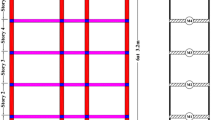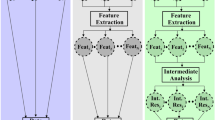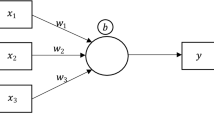Abstract
Storey-level detection of high-rise buildings has become a subject of focus but still inadequate, whereas element-level detection is by far not reached because of the complexity of tall buildings, especially in a three-dimensional (3D) problem. In this study, element-level detection of two 3D 30-storey 90-m-high RC buildings (symmetrical and asymmetrical) composed of 2880 degrees of freedom (DOFs) is aimed. Only one biaxial accelerometer per floor is required to measure lateral displacements, making the number of measured DOFs equal to about 2% of the full system. To circumvent the complicated problem, a two-step procedure is proposed to detect damage at storey and then element levels. The backbone idea lies in the similarities in terms of bending behaviour at low modes between tall buildings and beam-like systems. Particularly, in Step 1, in each direction, a full 3D building is approximately simplified to a beam-like system using the Guyan static condensation procedure based on the measured DOFs. Thereafter, an eigenvalue problem-based inverse solution is implemented directly on the simplified system to detect damaged storeys using only the first two bending modes. In Step 2, an artificial neural network model is designed to indicate ruined shear walls and columns focusing only on the preliminarily identified storeys, effectively reducing the number of desired variables. Only modal data at the lowest three swaying modes are accounted for. As a result, storey- and element-level detection is accurately achieved as long as the identified modal data are noise-free or low-level noise polluted.




















Similar content being viewed by others
References
Nguyen-Le DH, Tao QB, Nguyen VH, Wahabd MA, Nguyen-Xuan H (2020) A data-driven approach based on long short-term memory and hidden Markov model for crack propagation prediction. Eng Fract Mech 235:107085. https://doi.org/10.1016/j.engfracmech.2020.107085
Kim JT, Stubbs N (2002) Improved damage identification method based on modal information. J Sound Vib 252(2):223–238. https://doi.org/10.1006/jsvi.2001.3749
Yan YJ, Cheng L, Wu ZY, Yam LH (2007) Development in vibration-based structural damage detection technique. Mech Syst Signal Pr 21(5):2198–2211. https://doi.org/10.1016/j.ymssp.2006.10.002
Tran-Ngoc H, Khatir S, Le-Xuan T, De Roeck G, Bui-Tien T, Abdel-Wahab M (2020) A novel machine-learning based on the global search techniques using vectorized data for damage detection in structures. Int J Eng Sci 157:103376. https://doi.org/10.1016/j.ijengsci.2020.103376
Tran-Ngoc H, Khatir S, De Roeck G, Bui-Tien T, Nguyen-Ngoc L, Abdel-Wahab M (2018) Model updating for Nam O Bridge using particle swarm optimization algorithm and genetic algorithm. Sensors 18(12):4131. https://doi.org/10.3390/s18124131
Gillich GR, Furdui H, Abdel-Wahab M, Korka ZI (2019) A robust damage detection method based on multi-modal analysis in variable temperature conditions. Mech Syst Signal Process 115:361–379. https://doi.org/10.1016/j.ymssp.2018.05.037
Nguyen QT, Livaoğlu R (2022) A modal strain energy based updating procedure for damage detection: a numerical investigation. J Mech Sci Technol 36(4) (In Press)
Dinh-Cong D, Pham-Toan T, Nguyen-Thai D, Nguyen-Thoi T (2019) Structural damage assessment with incomplete and noisy modal data using model reduction technique and LAPO algorithm. Struct Infrastruct Eng 15(11):1436–1449. https://doi.org/10.1080/15732479.2019.1624785
Limongelli MP (2011) The interpolation damage detection method for frames under seismic excitation. J Sound Vibr 330(2011):5474–5489. https://doi.org/10.1016/j.jsv.2011.06.012
Paral A, Roy DKS, Samanta AK (2019) Application of a mode shape derivative-based damage index in artificial neural network for structural damage identification in shear frame building. J Civ Struct Health Monit 9:411–423. https://doi.org/10.1007/s13349-019-00342-x
Chang CM, Lin TK, Chang CW (2018) Applications of neural network models for structural health monitoring based on derived modal properties. Measurement 129:457–470. https://doi.org/10.1016/j.measurement.2018.07.051
Khatir S, Boutchichab D, Thanh CL, Tran-Ngoc H, Nguyen TN, Abdel-Wahab M (2020) Improved ANN technique combined with Jaya algorithm for crack identification in plates using XIGA and experimental analysis. Theor Appl Fract Mech 107:102554. https://doi.org/10.1016/j.tafmec.2020.102554
Nguyen HD, Tran H, De Roeck G, Bui TT, Wahab MA (2020) Damage detection in truss bridges using transmissibility and machine learning algorithm: Application to Nam O bridge. Smart Struct Syst 26(1): 487–499. Doi: https://doi.org/10.12989/sss.2020.26.1.035.
Bakhary N (2008) Structural condition monitoring and damage identification with artificial neural network. Dissertation, School of Civil and Resource Engineering, The University of Western Australia, Australia
Hedayat AS, Sloane NJA, Stufken J (1999) Orthogonal arrays—Theory and Applications. Springer Verlag, New York, USA
Helton JC, Davis FJ (2003) Latin hypercube sampling and the propagation of uncertainty in analyses of complex system. Reliab Eng Syst Safe 81(1):23–69. https://doi.org/10.1016/S0951-8320(03)00058-9
Nguyen TQ, Livaoğlu R (2021) Combination of an inverse solution and an ANN for damage identification on high-rise buildings. Smart Struct Syst, 28(3):375–390. Doi: https://doi.org/10.12989/sss.2021.28.3.375.
Nguyen TQ, Livaoğlu R (2022) Damage detection of high-rise buildings using an eigenvalue problem-based inverse solution. Soil Dyn Earthq Eng 152:107019. https://doi.org/10.1016/j.soildyn.2021.107019
Guyan RJ (1965) Reduction of stiffness and mass matrices. AIAA J 3:380–380
Fukunaga K (1990) Introduction to statistical pattern recognition. Academic Press, New York
Gibson JD, Melsa JL (1975) Introduction to nonparametric detection with applications. Academic press, New York
Khatir S, Tiachacht S, Thanh CL, Ghandourah E, Mirjalili S, Wahab MA (2021) An improved artificial neural network using arithmetic optimization algorithm for damage assessment in FGM composite plates. Compos Struct 273:114287. https://doi.org/10.1016/j.compstruct.2021.114287
Zenzen R, Khatir S, Belaidi I, Thanh CL, Wahab MA (2020) A modified transmissibility indicator and artificial neural network for damage identification and quantification in laminated composite structures. Compos Struct 248:112497. https://doi.org/10.1016/j.compstruct.2020.112497
Hagan MT, Demuth HB, Beale M (1995) Neural network design. PWS Publishing Company
Shih Y (1994) Neuralyst user’s guide. Cheshire Engineering Corporation
Sloane NJA, A Library of Orthogonal Arrays. Accessed September 2021. http://neilsloane.com/oadir/
Tran-Ngoc H, Khatir S, Ho-Khac H, De Roeck G, Bui-Tien T, Wahab MA (2021) Efficient Artificial neural networks based on a hybrid metaheuristic optimization algorithm for damage detection in laminated composite structures. Compos Struct 262:113339. https://doi.org/10.1016/j.compstruct.2020.113339
Hagan MT, Menhaj M (1994) Training feedforward networks with the Maquardt algorithm. IEEE Trans Neural Netw 5:989–993
Gately E (1996) Neural networks for financial forecasting. John Wiley and Sons, New York, USA
Samami H, Oyadiji SO (2016) Simulation and detection of small crack-like surface flaws and slots in simply-supported beams using curvature analysis of analytical and numerical modal displacement data. Eng Comput 33(7):1969–2006. https://doi.org/10.1108/EC-02-2015-0032
Shi ZY, Law SS, Zhang LM (1998) Structural damage localization from modal strain energy change. J Sound Vib 218(5):825–844. https://doi.org/10.1006/jsvi.1998.1878
Xiang J, Liang M, He Y (2014) Experimental investigation of frequency-based multi-damage detection for beams using support vector regression. Eng Fract Mech 131:257–268. https://doi.org/10.1016/j.engfracmech.2014.08.001
Fu F (2018) Design and analysis of tall and complex structures, Butterworth-Heinemann
Li QS, Zhi LH, Tuan AY, Kao CS, Su SC, Wu CF (2011) Dynamic Behavior of Taipei 101 tower: field measurement and numerical analysis. J Struct Eng 137:143–155. https://doi.org/10.1061/(ASCE)ST.1943-541X.0000264
Khatir S, Wahab MA, Boutchicha D, Khatir T (2019) Structural health monitoring using modal strain energy damage indicator coupled with teaching-learning-based optimization algorithm and isogeometric analysis. J Sound Vibr 448:230–246. https://doi.org/10.1016/j.jsv.2019.02.017
Ghannadi P, Kourehli SS (2020) An effective method for damage assessment based on limited measured locations in skeletal structures. Adv Struct Eng 24:183–195. https://doi.org/10.1177/1369433220947193
Tiachacht S, Khatir S, Le-Thanh C, Rao RV, Mirjalili S, Wahab MA (2021) Inverse problem for dynamic structural health monitoring based on slime mould algorithm. Eng Comput. https://doi.org/10.1007/s00366-021-01378-8
Taranath BS (2016) Tall Building design: steel, concrete, and composite systems. CRC Press, Boca Raton
Rist VC, Svensson S (2016) Methodology for preliminary design of high-rise buildings. Master's Dissertation, Faculty of Engineering LTH, Lund University, Sweden
Taranath BS (2010) Reinforced concrete design of tall buildings. CRC Press
Pejovic JR, Serdar NN, Pejovic, RR (2017) Optimal intensity measures for probabilistic seismic demand models of RC high rise buildings. Earthq Struct 13(3): 221–230. Doi: https://doi.org/10.12989/eas.2017.13.3.221.
Yang Z, Wang L (2010) Structural damage detection by changes in natural frequencies. J Intell Mater Syst Struct 21(3):309–319. https://doi.org/10.1177/1045389X09350332
An G (1996) The effects of adding noise during backpropagation training on a generalization performance. Neural Comput 8(3):643–674. https://doi.org/10.1162/neco.1996.8.3.643
Hjelmstad KD, Shin S (1997) Damage detection and assessment of structures from static response. J Eng Mech 123(6):568–576. https://doi.org/10.1061/(ASCE)0733-9399(1997)123:6(568)
Beale MH, Hagan MT, Demuth HB (2018) Neural network toolbox™ getting started guide. The MathWorks Inc, MA
Taylor R (1990) Interpretation of the correlation coefficient: a basic review. J Diagn Med Sonog 6(1):35–39. https://doi.org/10.1177/875647939000600106
Author information
Authors and Affiliations
Corresponding author
Ethics declarations
Conflict of interest
Quy Thue Nguyen and Ramazan Livaoğlu declare that they have no conflict of interest.
Additional information
Publisher's Note
Springer Nature remains neutral with regard to jurisdictional claims in published maps and institutional affiliations.
Rights and permissions
About this article
Cite this article
Nguyen, Q.T., Livaoğlu, R. Damage detection at storey and element levels of high-rise buildings: a hybrid method. Neural Comput & Applic 34, 12765–12788 (2022). https://doi.org/10.1007/s00521-022-07111-w
Received:
Accepted:
Published:
Issue Date:
DOI: https://doi.org/10.1007/s00521-022-07111-w




